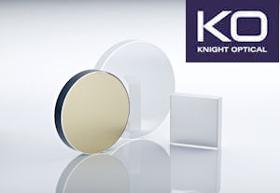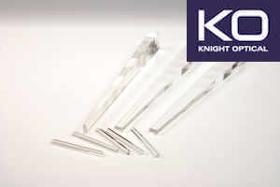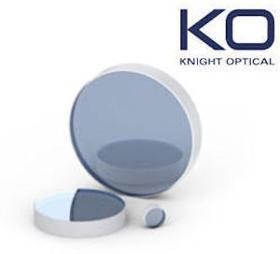- europages
- >
- COMPANIES - SUPPLIERS - SERVICE PROVIDERS
- >
- laser
Results for
Laser - Import export

KNIGHT OPTICAL (UK) LTD
United Kingdom
Knight Optical supply custom laser mirrors for use at specific laser lines from the UV (200 to 400nm) to the IR (1to 40µm) wavebands. The laser mirrors can be custom made to include the following range: 1 YAG laser mirrors (High power grade) 2 Excimer laser mirrors (High power grade) 3 Argon-ion laser mirrors (High power grade) 4 Diode & broadband (Ti:Sapphire) These mirrors are made from vacuum depositing thin films of material that have differing refractive indices & thickness onto suitable substrates. Typical custom laser mirror substrates are calcium fluoride, germanium, sapphire, fused silica and Zinc Selenide which produce a high efficiency reflecting surface at the laser wavelength. Read PDF for more information.
Request for a quote
KNIGHT OPTICAL (UK) LTD
United Kingdom
Knight Optical offer a range of Stock Ball Lenses and Half Ball Lenses, for use within Fibre Lasers. As the name suggests ball lenses are completely spherical lenses mostly made out of High Refractive Index Glass such as Sapphire, and LASFN-9 Glass. The reason ball lenses are most commonly used is for their ability to focus light when leaving a fibre optic, so that it can therefore be used for a laser application. The key feature of ball lenses is their short back focal length allowing for precision coupling where size or space is a limiting factor in the system. Ball lenses are typically used in pairs with one lens acting as a collimator for the second to focus the light back into the coupled fibre. Where a more compact solution is required a half-ball lens is typically more suitable. We hold a large inventory of Ball Lenses. •Stock sizes from 0.5 5mm to 10mm diameter. •Custom sizes available to quotation. •Half Ball lenses also available.
Request for a quote
KNIGHT OPTICAL (UK) LTD
United Kingdom
Knight Optical can offer you Plane Mirrors (general, λ/1 and λ/4), for use within Laser Distance Measurement Applications in a range of materials such as Soda-lime float glass, white float glass, and BK7 glass. Plane mirrors also known as front surface mirrors or first surface mirrors are used widely within Laser Distance Measurement applications. As stock we hold a number of general purpose, λ/1 and λ/4 with a range of up to 6 types of coatings such as Enhanced Aluminium, Ali/SiO2 and Ali/Mgf2. Our general purpose grade mirrors are made from good quality float glass and generally available in thicknesses of 1mm, 3mm and 6mm as standard. Laser Distance Measurement devices utilise the use of a laser beam to be able to determine the distance of an object. How optical mirrors are used in conjunction with these devices is that, a mirrored surface can be measured with a laser tracker; which will help determine the distance between the laser distance Read PDF for full information..
Request for a quote
KNIGHT OPTICAL (UK) LTD
United Kingdom
Ball Lenses are widely used for focusing & coupling light into & out of fibres. With the high refractive index of Sapphire (Al2O3) material, it yields a low spherical aberration that can be used in the range of UV from 200nm up to 5µm, and with it being one of the hardest materials they are resistant to damage. The key feature of ball lenses is their short back focal length allowing for precision coupling where size or space is a limiting factor in the system. Typically used in pairs, where one lens acts as collimator for the second to focus the light back into the coupled fibre. Ball Lenses are manufactured from a single substrate of glad and therefore, depending on the geometry of the input source, can focus or collimate light. Half Ball Lenses can also be used as an interchange with a full ball lens for more compact designs. Read the PDF for more information...
Request for a quote
KNIGHT OPTICAL (UK) LTD
United Kingdom
Due to high intensity light from the laser, mirrors used with a laser application require a high damage threshold, and high reflectivity. Knight Optical can help! Laser mirrors are used to reflect or redirect the laser. This manipulation of the beam means it is great for laser applications where there is limited space, as the beam can be steered multiple times. We manufacture mirrors used in the UV/VIS/NIR and infrared. We provide a number of mirrors from stock with coatings at infrared wavelengths such as: Dielectric (98% NIR) Protected Silver (96% VIS/NIR) Protected Gold (97%@750-FAR IR) These are available to purchase from stock in a wide ranges of sizes from 6.3 mm in diameter to a 300mm x 300mm square and various different thicknesses. They are also available with varying flatness specifications with λ/10 also available for immediate shipment and for you to achieve the highest performance. Read PDF for full specification..
Request for a quoteDo you sell or make similar products?
Sign up to europages and have your products listed

KNIGHT OPTICAL (UK) LTD
United Kingdom
Intense Pulsed Light Systems use not only use filters, that are used to filter out the UV wavelength range; and transmit between 400-1200nm for use within cosmetic lasers that are designed to remove unwanted hair, vascular treatment and even acne treatment. But they also use Homogenizing Rods to help evenly distribute light. The Light source will enter a light pipe at a variety of incident angles, which is designed to utilise its total internal reflection to channel the light from the entrance of the light pipe to the exit. The material’s refractive index is the only factor which affects the light pipes critical angle; this defines the angle of acceptance which the total internal reflection will occur at. All our Homogenizing Rods are fully inspected on their quality in our ISO 9001 certified, state-of-the-art Metrology laboratory, using our Trioptic’s PrismMaster, and Starrett AV300 Video Imaging System.. FOR MORE INFORMATION READ PDF..
Request for a quote
KNIGHT OPTICAL (UK) LTD
United Kingdom
Intense Pulsed Light Systems use not only use filters, that are used to filter out the UV wavelength range; and transmit between 400-1200nm for use within cosmetic lasers that are designed to remove unwanted hair, vascular treatment and even acne treatment. But they also use Homogenizing Rods to help evenly distribute light. The Light source will enter a light pipe at a variety of incident angles, which is designed to utilise its total internal reflection to channel the light from the entrance of the light pipe to the exit. The material’s refractive index is the only factor which affects the light pipes critical angle; this defines the angle of acceptance which the total internal reflection will occur at. All our Homogenizing Rods are fully inspected on their quality in our ISO 9001 certified, state-of-the-art Metrology laboratory, using our Trioptic’s PrismMaster, and Starrett AV300 Video Imaging System.. FOR MORE INFORMATION READ PDF..
Request for a quote
KNIGHT OPTICAL (UK) LTD
United Kingdom
As well as Knight Optical’s Low GDD Ultrafast Laser Mirrors, we can also provide broadband and wide-angle alternatives to cover more of a range of applications. Our Wide-Angle Laser Mirrors optimised for the fundamental and second harmonic (SHG) emissions of Ytterbium (Yb) doped lasers including diode-pumped solid-state (DPSS) and fiber lasers, and therefore have a design wavelength of either 515nm or 1030nm. They exhibit > 99.9% reflection when used between 0 to 45°. The Broadband Laser Mirrors work from 700-900nm ideal for applications using a Ti:Sapphire laser, again demonstrating > 99.9% reflection within this wavelength range. Their key features include: •Ion beam sputtered (IBS) coating which is compact and durable. •Reflection > 99.9% within their design wavelength range. •Broadband laser mirrors work at 45° •Exhibit minimal group delay dispersion (GDD) to prevent pulse broadening •High laser induced damage threshold (LIDT) •Precision flatness and surface quality to
Request for a quote
KNIGHT OPTICAL (UK) LTD
United Kingdom
Knight Optical can offer you stock and custom lambda/10 mirrors for use in government testing for aerospace, in a range of materials such as BK7 or equivalent, Zerodur, Quartz, UV Fused Silica and many more. Mirrors are made from low expansion glass for optimum stability to maintain the lambda/10 flatness. The mirrors help produce high quality images and can be coated with a variety of coatings to ensure that the perfect quality image in the wavelength you require is achieved: Enhanced aluminium 94%R for visible applications. 99.9% dielectric for laser use in visible applications. UV aluminium for UV applications down to 180nm. 98.5% dielectric for laser use in the NIR applications. Ion plated silver for NIR-2000nm applications. Protected gold for 750nm to far infra-red applications λ/10 mirrors are used in the aerospace environment due to the vibration, temperatures & pressure through which they are exposed. To Find out More read the PDF
Request for a quote
KNIGHT OPTICAL (UK) LTD
United Kingdom
The laser mirrors can be custom made to include the following range: 1 YAG laser mirrors (High power grade) 2 Excimer laser mirrors (High power grade) 3 Argon-ion laser mirrors (High power grade) 4 Diode & broadband (Ti:Sapphire) These mirrors are made from vacuum depositing thin films of material that have differing refractive indices & thickness onto suitable substrates. Typical custom laser mirror substrates are calcium fluoride, germanium, sapphire, fused silica and Zinc Selenide which produce a high efficiency reflecting surface at the laser wavelength. The coatings are assembled assuming that the mirror will be working in the plane of incidence. This is essential as any off-axis angles will push the pass band toward the shorter waveband that could be beyond the pass band for one or both polarizations (s and p). If off-axis reflections are needed, such as at 90°, then this coating needs to be applied for an Angle of Incidence (AOI) of 45°. READ PDF FOR MORE INFO ..
Request for a quoteResults for
Laser - Import exportNumber of results
11 ProductsCountries
Company type